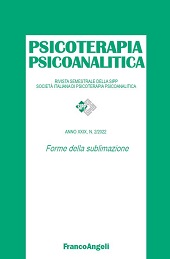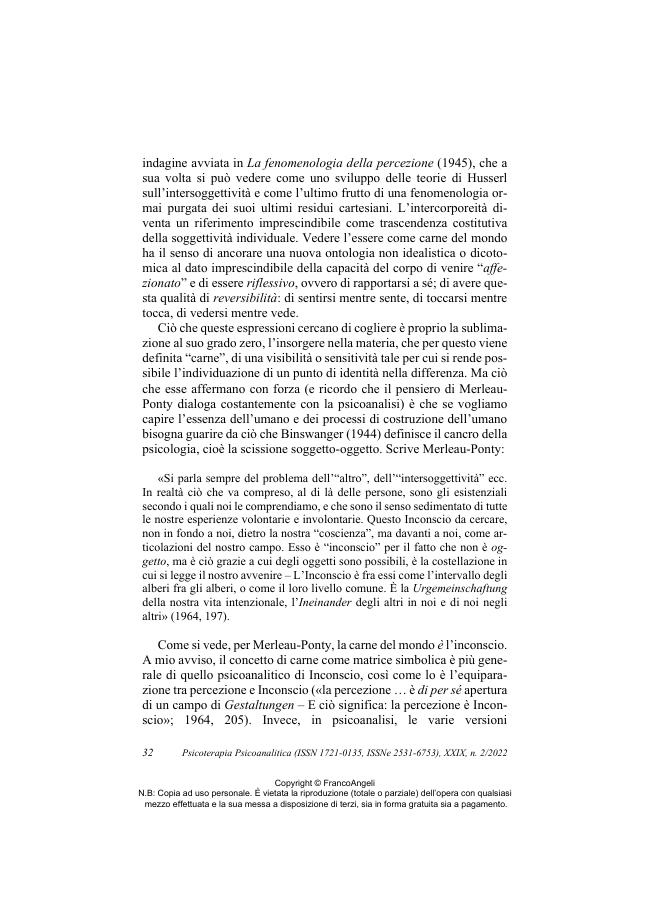2022 - Franco Angeli
Article
Digital Version
Download | Copy/paste | Printing
La sublimazione reinventata
P. 21-43
- La teoria della sublimazione riassume la teoria freudiana dell'arte. Benché sia così intuitiva da essere passata nella cultura popolare, è sempre stata ritenuta una teoria lacunosa. In questo articolo, l'ipotesi di lavoro dell'autore è che sia possibile reinventarla a partire dalla teoria estetica del sublime. Difatti sublimazione e sublime esprimono entrambe l'idea di un'ascesa del soggetto verso le vette più alte dell'umanità. Entrambe sono teorie dell'elevazione spirituale e di conquista morale dell'uomo, ed entrambe tentano di spiegare il mistero dell'esperienza estetica. Quel che l'estetica del sublime ci aiuta a vedere in maniera più chiara e distinta è che si tratta di un processo intrinsecamente intersoggettivo. In gioco nella crescita psichica è sempre la tessitura di nuovi legami, che però siano anche legami affettivi.
- Dal confronto tra le due teorie possono scaturire intuizioni suggestive sulla costituzione sociale ed estetica (cioè basata sulle sensazioni corporee) del soggetto alla nascita: al punto di partenza del processo di soggettivazione, e poi in seguito per tutta la vita (non si smette mai di nascere). Così reinterpretato, il concetto di sublimazione, una metafora che Freud prende in prestito dalla chimica, dove designa il passaggio di una sostanza dallo stato solido allo stato aeriforme, indica a meraviglia il processo di ascesa dal caos all'ordine, dal concreto al simbolico, dal corpo allo spirito. La sublimazione-come-riconciliazione con l'altro, che si svolge simultaneamente sul piano del pensiero verbale e dell'intenzionalità corporea, può fungere allora da modello dell'azione terapeutica. [Testo dell'editore]
- The theory of sublimation summarizes the Freudian theory of art. Although it is so intuitive that it has passed into popular culture, it has always been considered a weak theory. In this article, the author's working hypothesis is that it is possible to reinvent it from the aesthetic theory of the sublime. In fact, sublimation and sublime both express the idea of the subject's ascent to the highest peaks of humanity. Both are theories of man's spiritual elevation and moral achievement, and both attempt to explain the mystery of aesthetic experience. What the aesthetics of the sublime helps us to see more clearly and distinctly is that it is an inherently intersubjective process. At stake in psychic growth is always the weaving of new bonds, which, however, are also affective bonds.
- Comparison of the two theories may yield sug-gestive insights into the social and aesthetic (i.e., based on bodily sen-sations) constitution of the subject at birth: at the starting point of the process of subjectivation, and then thereafter throughout life (one nev-er stops being born). Thus reinterpreted, the concept of sublimation, a metaphor Freud borrows from chemistry, where it designates the transition of a substance from solid to aeriform state, wonderfully points to the process of ascending from chaos to order, concrete to symbolic, body to spirit. The sublimation-as-reconciliation with the other, that takes place simultaneously on the plane of verbal thought and bodily intentionality, can then serve as a model of therapeutic action. [Publisher's text]
Is part of
Psicoterapia psicoanalitica : 2, 2022-
Information
ISSN: 2531-6753
KEYWORDS
- Sublimazione, sublime, intercorporeità, teoria del campo analitico, creatività, at-one-ment
- Sublimation, sublime, intercorporeality, field theory, creativity, at-one-ment
-
In this issue
- Editoriale
- La sublimazione reinventata
- Sublime distopico
- Sulla sublimazione : il destino indiretto della pulsione : rivisitazione di un concetto fondante nella teoria, la clinica, l'arte e la civiltà
- Sublimazione e civilizzazione : all'origine del processo di soggettivazione in adolescenza
- Amore mio caro : riflessioni intorno a una lettera del giovane Freud alla fidanzata Martha Bernays
- The Kid di Charlie Chaplin : storia di un capolavoro : dal trauma alla creatività
- Sublimi azioni : nota sulla fotografia transfigurativa
- La sublimazione come capacità dell'analista e come funzione : una solidarietà sublimata
- Tra regressione e sublimazione : fusionalità, bellezza e manutenzione dei confini
- La sublimazione, conquista del percorso terapeutico
- Una quieta passione : cambiare l'acqua ai fiori
- L'occhio di Polifemo : sublimazioni in corto
- Dimmi che lingua parli? : il multilinguismo di un gruppo di apprendimento della lingua francese con pazienti gravi
- Recensioni
- Norme redazionali



